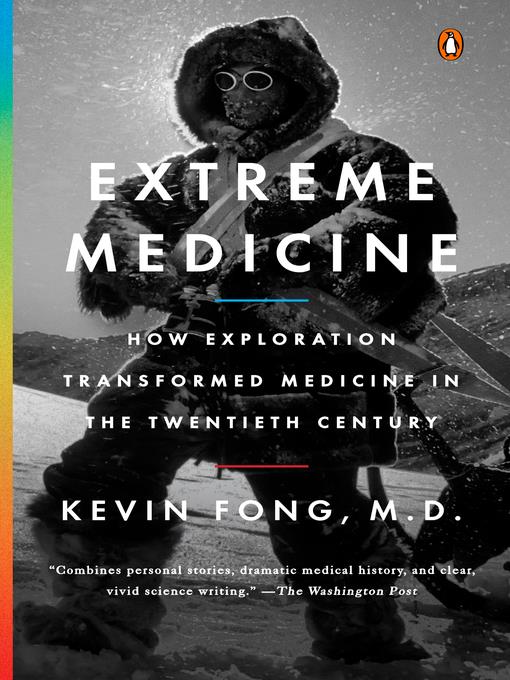
Extreme Medicine
How Exploration Transformed Medicine in the Twentieth Century
چگونه پزشکی انتقالی در قرن بیستم
کتاب های مرتبط
- اطلاعات
- نقد و بررسی
- دیدگاه کاربران
نقد و بررسی

December 2, 2013
British doctor and space enthusiast Fong launches a gripping “exploration of the extreme tolerances of the human body” in this eloquent history of how 20th-century science and medicine moved us toward “improved survival”—and with it a better understanding of life and death. He begins with a tale of a young Norwegian woman’s incredible survival after deep hypothermia and moves on to describe the remarkable strides in burn care built on reconstructive surgery during WWII. Further along in his journey, Fong details the daring operations that opened “the continent of the heart,” and how the polio epidemic—which touched Fong’s own family—begat the fields of anesthesiology and intensive care. From the heart-pounding tale of how a fatal accident helped a grieving doctor develop life-saving trauma care to a moving depiction of the end of human life, these are thrilling stories that describe the limits of human physiology. But they have a more profound meaning as well, Fong finds. Whether it’s the 1912 South Pole expedition that claimed the life of Robert Falcon Scott or the obstacles that await our species as we prepare for outer space travel, Fong concludes, “We explore simply because we must.”

Starred review from December 15, 2013
The founder of the Centre for Altitude, Space, and Extreme Environment Medicine examines the connections between extraordinary advances in modern medicine and the experiences of explorers, mountaineers, soldiers and others who face extreme conditions. An intensive-care physician who also studied astrophysics and engineering, Guardian contributor Fong shares a unique point of view on the development of intensive care as a medical discipline. "Much of the [modern] advance [in saving life]...has come through wrapping fragile human physiology in concentric layers of artificial life support and allowing it to be projected into extremes that we were never before able to survive," writes the author, who provides many fascinating examples--e.g., in 1999, the miraculous recovery of a Norwegian doctor who almost died after a skiing accident. When rescued after being submerged in icy water for more than 40 minutes after a fall, she was not breathing and had no discernible pulse. Her medical colleagues used heroic methods to save her, calling upon the skills of a surgical anesthesiologist and applying techniques pioneered in open-heart surgery. This prompted the recognition that deliberately inducing "hypothermic arrest" and bringing a patient to the point of death extended the time available for complex, life-threatening surgical operations. Similarly, the treatment of wartime casualties during World War II led to major advances in the treatment of severe burns--and the first successful face transplant in 2009. The key was to artificially maintain blood circulation in skin grafts to the affected areas. Fong believes that the demands of manned space flights to Mars will drive new frontiers of medicine. Today, we are only beginning to deal with medical problems (e.g., loss of calcium in bones, inner-ear problems with balance) faced by astronauts who spend time in zero-gravity environments and then return to Earth. A medical thriller of the first order.
COPYRIGHT(2013) Kirkus Reviews, ALL RIGHTS RESERVED.

February 15, 2014
A woman dies of hypothermia and is revived two hours later. A doctor and his family are in plane crash and a simple, life-saving mnemonic is developed. Fong, a doctor and codirector of the Aviation Space and Extreme Environment Medicine at University College London, links the history of medicine to extremes. The author draws from history and his own experience to craft an engaging narrative of early burn wards, the destructive and curative promise of hypothermia, crushing pressures of diving, high-altitude sickness, expected health issues of missions to Mars, and the future of elder care. This inspiring read shows how far medicine has advanced the use of ambulances and helicopters, intensive care units, and the other technologies that vastly improve the likelihood of surviving trauma and diseases that otherwise would be fatal. The narrative feels disjointed at times as the author jumps from one story to another but ties together nicely at the conclusion of each chapter. VERDICT Fans of history, medicine, space exploration, and sf will find this book difficult to put down.--Susanne Caro, Univ. of Montana Lib., Missoula
Copyright 2014 Library Journal, LLC Used with permission.

December 15, 2013
Inner space, outer space, and regions in betweenthis is the sprawling subject matter of a book that celebrates the challenges of discovery. Fong, a physician with a background in astrophysics, engineering, and aerospace medicine, ably identifies the correlations and convergence of exploring extreme environments and predicaments and the human body. For example, he tethers an expedition to the South Pole with forthcoming medical applications of hypothermia. He links the disfiguring burns suffered by WWII aircraft pilots with the development of reconstructive plastic surgery. Fong focuses on the fragility of human physiology and efforts to protect it with advanced life-support systems. Along the way, readers learn about the rise of intensive-care units, human spaceflight, iron lungs and polio, a complete face transplant, and SARS. Exploration of any kind is risky business and at times seems irrational. It requires curiosity, innovation, and resiliency, and it pushes the limits of knowledge, territory, and biology. Fong makes the point that human survival has been and will continue to be closely connected to our compulsion to explore.(Reprinted with permission of Booklist, copyright 2013, American Library Association.)

























دیدگاه کاربران